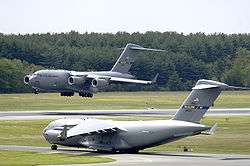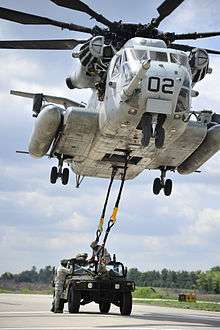Joint Base McGuire–Dix–Lakehurst
Joint Base McGuire–Dix–Lakehurst (JB MDL) is a United States military facility located 18 miles (29 km) southeast of Trenton, New Jersey. The base is the only tri-service base in the United States Department of Defense and includes units from all five armed forces branches.
| Joint Base McGuire–Dix–Lakehurst | |||||||||
|---|---|---|---|---|---|---|---|---|---|
| Near Wrightstown and Lakehurst, New Jersey in the United States of America | |||||||||
 A C-17A Globemaster III from the 305th Air Mobility Wing performs touch and go landings while another C-17A prepares for take-off at JB McGuire-Dix-Lakehurst. | |||||||||
 | |||||||||
 JB McGuire-Dix-Lakehurst Location in the United States | |||||||||
| Coordinates | 40°00′56″N 074°35′30″W (Air Base) 40°01′09″N 74°31′22″W (Army Base) 40°02′00″N 074°21′13″W (Naval Station) | ||||||||
| Type | US military Joint Base | ||||||||
| Site information | |||||||||
| Owner | Department of Defense | ||||||||
| Operator | US Air Force | ||||||||
| Controlled by | Air Mobility Command (AMC) | ||||||||
| Condition | Operational | ||||||||
| Website | www | ||||||||
| Site history | |||||||||
| Built | 1916 (as Camp Kendrick) 1917 (as Camp Dix) 1937 (as Fort Dix Airport) | ||||||||
| In use | 2009 – present (as Joint Base) | ||||||||
| Garrison information | |||||||||
| Current commander | Colonel Bridget V. Gigliotti (USAF) | ||||||||
| Garrison |
| ||||||||
| Airfield information | |||||||||
| Identifiers | IATA: WRI, ICAO: KWRI, FAA LID: WRI, WMO: 724096 | ||||||||
| Elevation | 42.9 metres (141 ft) AMSL | ||||||||
| |||||||||
| Other Facilities | See Lakehurst Maxfield Field for its airfield data. | ||||||||
| Source: Federal Aviation Administration[1] | |||||||||
The facility is an amalgamation of the United States Air Force's McGuire Air Force Base, the United States Army's Fort Dix and the United States Navy's Naval Air Engineering Station Lakehurst, which were merged on 1 October 2009.
It was established in accordance with congressional legislation implementing the recommendations of the 2005 Base Realignment and Closure Commission. The legislation ordered the consolidation of the three facilities which were adjoining, but separate military installations, into a single joint base, one of 12 formed in the United States as a result of the law.
The installation commander is Air Force Colonel Bridget V. Gigliotti[2]
Overview
The 42,000-contiguous acres of JB MDL are home to more than 80 mission partners and 40 mission commanders providing a wide range of combat capability. The base spans more than 20 miles, from east to west. It is situated in the two largest counties in New Jersey, Burlington and Ocean, and includes portions of eight municipalities: the borough of Wrightstown and the townships of New Hanover, North Hanover, Pemberton, and Springfield, in Burlington County, and the townships of Jackson, Manchester, and Plumsted in Ocean County. The 87th Air Base Wing provides installation management support for 3,933 facilities with an approximate value of $9.3 billion in physical infrastructure. More than 44,000 airmen, soldiers, sailors, marines, Coast Guardsmen, civilians, and their family members live and work on and around JB MDL, which has an economic impact on the state of New Jersey.[3]
McGuire/McGuire AFB
- See: McGuire Air Force Base for additional information and history.
The base originated in 1941 as Fort Dix Army Air Force Base. Closed briefly after World War II, it reopened in 1948 as McGuire Air Force Base. The base was named after Major Thomas B. McGuire, Jr., Medal of Honor recipient, and the second leading ace in American history.[4]
McGuire grew famous as the Air Force's "Gateway to the East", when its core mission became global mobility in 1945. In 1992, it became part of the newly reorganized Air Mobility Command.[4]
The 305th Air Mobility Wing served as the host wing from October 1994 to March 2009, when the newly activated 87th Air Base Wing assumed installation command. The 305th, along with the 108th Air Wing (ANG), 621st Contingency Response Wing, and the 514th Air Mobility Wing (AFRES), has supported every major type of air mobility mission over the past 15 years.[4]
McGuire organizations
- 87th Air Base Wing (Host organization for JB MDL)
- 305th Air Mobility Wing (C-17 Airlift, KC-10 Air Refueling operations for McGuire AFB/Lakehurst)
- 621st Contingency Response Wing (Rapid Response unit)
- 514th Air Mobility Wing (C-17 Airlift, KC-10 Air Refueling) (Air Force Reserve)
- 108th Wing (KC-135 Air Refueling) (Air National Guard)
- 57th Weapons Squadron (USAF Weapons School C-17 training unit, GSU from Nellis AFB, Nevada)
- 314th Recruiting Squadron
- CAP Det 1
- 373rd Training Squadron, Det 1
Source:[4]
Dix
- See: Fort Dix for additional information and history.
The facility originated in 1917 as Camp Dix, named in honor of Major General John Adams Dix, a veteran of the War of 1812 and the Civil War, and a former United States Senator, Secretary of the Treasury and Governor of New York.[5] It was renamed Fort Dix in 1939.
Dix has a history of mobilizing, training and demobilizing Soldiers from as early as World War I through the present day. In 1978, the first female recruits entered basic training at Fort Dix. In 1991, Dix trained Kuwaiti civilians in basic military skills so they could take part in their country's liberation.[5]
Dix ended its active Army training mission in 1988 due to Base Realignment and Closure Commission recommendations. It began a new mission of mobilizing, deploying and demobilizing Soldiers and providing training areas for Army Reserve and Army National Guard Soldiers.[5]
In 1994, the United States Air Force Expeditionary Center was established as the Air Mobility Warfare Center on Dix.[5]
Fort Dix organizations
- Army Support Activity
- Marine Aircraft Group 49
- 99th Regional Support Command
- 2d Brigade, 75th Division
- USCG Atlantic Strike Team
- U.S. Air Force Expeditionary Center
- Military Entrance Processing Station
- NCO Academy
- Navy Operational Support Center
- 174th Infantry Brigade
- Fleet Logistics Squadron (VR-64)
- 244th Aviation Brigade
- Golf Battery, 3rd Battalion/14th Marines
- Joint Force Headquarters (JFHQ), NJARNG
- NJARNG Observer Coach/Trainer Operations Group
Source:[5]
Lakehurst
- See: Naval Air Engineering Station Lakehurst for additional information and history.

Lakehurst history begins as a munitions-testing site for the Imperial Russian Army in 1916. It was then gained by the United States Army as Camp Kendrick during World War I. The United States Navy purchased the property in 1921 for use as an airship station and renamed it Naval Air Station Lakehurst.[6]
The Navy's lighter-than-air program was conducted at Lakehurst through the 1930s. It was the site of the 1937 LZ 129 Hindenburg airship disaster. During World War II, anti-submarine patrol blimps were operated from Lakehurst. Since the 1950s, Aviation Boatswain's Mates have been trained at Lakehurst to operate catapults and arresting systems on aircraft carriers. Lakehurst conducts the unique mission of supporting and developing the Aircraft Launch and Recovery Equipment and Support Equipment for naval aviation. The Electromagnetic Aircraft Launch System and the Advanced Arresting Gear system that will replace the existing steam catapults and the Mk-7 arresting gear are being developed and tested at Lakehurst at full-scale shipboard representative test facilities here.[6]
Lakehurst organizations
- NAVAIR
- NAWCAD
- Center for Naval Educational Training, CNATT
- Naval Mobile Construction Battalion 21 (NMCB 21)
- Army 1st Brigade Mid-Atlantic Recruiting Battalion
- EAGLE FLAG
- 1-150th Assault Helicopter Battalion, NJARNG
Source:[6]
History
The Hindenburg disaster took place on Thursday, May 6, 1937, as the German passenger airship LZ 129 Hindenburg caught fire and was destroyed during its attempt to dock with its mooring mast at the Lakehurst Naval Air Station.
In February 2004, installation commanders from the three installations formed a partnership to generate joint solutions for common problems between the three contiguous bases and their tenant commands. The three installation commanders are already reducing operating costs by consolidating firearms training, radar information for air operations, and contracts for pest control, linen service, and hazardous waste disposal. This is a unique relationship. While each base serves its respective service directly, each base also takes advantage of the other bases' capabilities as part of a Joint Installation Partnership. For example:
- The Air Force plans to station a squadron of C-17 airlift aircraft at McGuire AFB. The C-17 often is required to take off and land from poorly prepared airfields, often in hostile territory. The airfield conditions at McGuire were not suitable for training for this type of operation. Navy Lakehurst has agreed to let the Air Force construct a practice assault landing strip at their airfield. The C-17s stationed at McGuire will train at Lakehurst and not interfere with normal aircraft operations at McGuire.
- The 421st Ground Combat Readiness Squadron is headquartered at McGuire and trains at Lakehurst.
- Mission partners on Lakehurst and McGuire use the live-fire training ranges on Dix, eliminating the need for individual ranges.
References
- "Airport Diagram – McGuire Field (Joint Baes McGuire Dix Lakehurst (KWRI)" (PDF). Federal Aviation Administration. 5 December 2019. Retrieved 18 December 2019.
- http://www.jointbasemdl.af.mil/About-Us/Biographies/Display/Article/826084/colonel-neil-r-richardson/
- Joint Base McGuire-Dix-Lakehurst Archived 2011-07-22 at the Wayback Machine
- Joint Base McGuire-Dix-Lakehurst McGuire Archived 2012-12-12 at Archive.today
- Joint Base McGuire-Dix-Lakehurst Dix Archived 2014-07-14 at the Wayback Machine
- "Joint Base McGuire-Dix-Lakehurst Lakehurst". Archived from the original on 2012-12-12. Retrieved 2010-06-18.

External links
| Wikimedia Commons has media related to Joint Base McGuire-Dix-Lakehurst. |
- Joint Base McGuire-Dix-Lakehurst (JB MDL) official website
- JB MDL Acronym Dictionary, JB MDL official website
- JB MDL Chapels, JB MDL official website
- Home page, JB MDL Chapel official website
- JB Chapel schedule and contact information (McGuire Chapel, North Chapel, Dix Chapel, Chapel of the Air), JB MDL Chapel official website
- Fort Dix Command Chaplain Section, Army Support Activity–Dix (ASA-Dix) official website
- JB.MDL.NJ (GoMDL.com) website (sponsored by the 87th Force Support Squadron)
- Air Mobility Command official website
- IMCOM Atlantic Region official website (U.S. Army Installation Management Command)

